A Microscope Built from Flesh and Bones Could Revolutionize Healthcare and Brain-Machine Interfaces
A Microscope Built from Flesh and Bones Could Revolutionize Healthcare and Brain-Machine Interfaces
Do you know what the real treatment for cancer is? No, it’s not a special drug, but rather early detection. Cancer starts its malicious life as one renegade cell. It grows quietly and is quite harmless for a long time. The problem is that it spreads stealthily and unnoticed throughout the human body, and often by the time it’s detected, it’s too late. If everyone could scan themselves daily with an MRI, we could detect cancer in time before it causes harm, eliminating the need for anyone to die from it. But this is not only true for cancer. Many serious diseases can be easily treated if detected early. Considering the leading causes of death, a system like this could offer almost everyone a longer and better quality of life. This is what OpenWater offers in healthcare, a cheap wearable MRI device.
When I first saw Mary Lou Jepsen’s TED talk on OpenWater in 2018, I immediately fell in love with the technology. As I listened to the presentation, a scene from ‘Minority Report’ came to mind, where they spoke briefly about the technology. In the scene, precogs lie in a bathtub, dreaming up visions of the future, which are then read from their brains using light. How absurd, I thought. Light can’t penetrate brain tissue. How could it possibly be used to read thoughts? Jepsen’s talk revealed that light can go through not just the brain tissue, but even the skull. The problem is that it scatters so much that it becomes completely unusable. This is where the brilliant technology of OpenWater comes in…
Jepsen and her team found a solution to focus light through living tissue using appropriately structured light. Essentially, they built a microscope whose lens system is made of flesh and bones. It sounds strange. But that’s exactly what it is. They can see into the human body by treating the living tissue as part of the system. Jepsen beautifully demonstrates this in her TED talk, where she places a piece of tissue in the path of a laser, and yet, a focused point appears on the wall instead of scattered light. To understand how this is possible, let’s look at Jepsen’s patent.
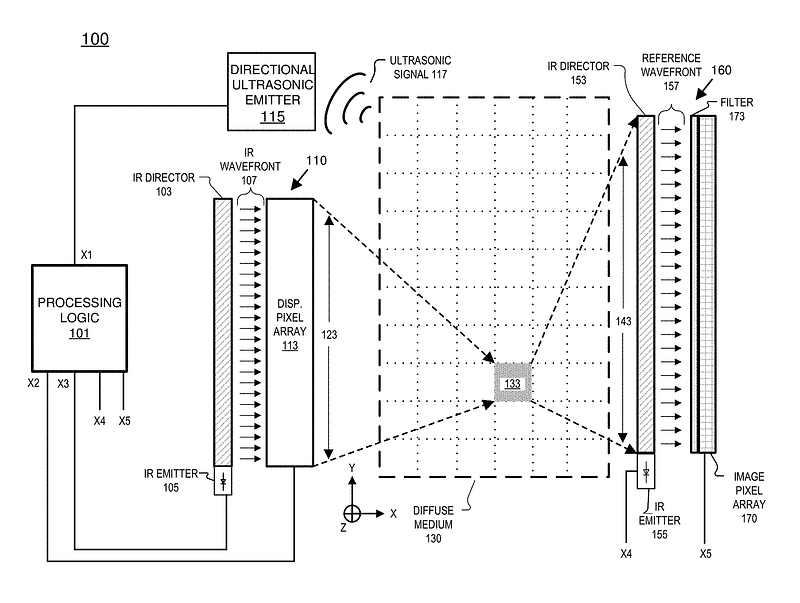
On the left side of the diagram, there’s a “hologram projector” (110), consisting of a laser emitter (105/103) and a special display (113). This display appropriately adjusts the phase of the light beams passing through it. But why is it called a “hologram projector“?
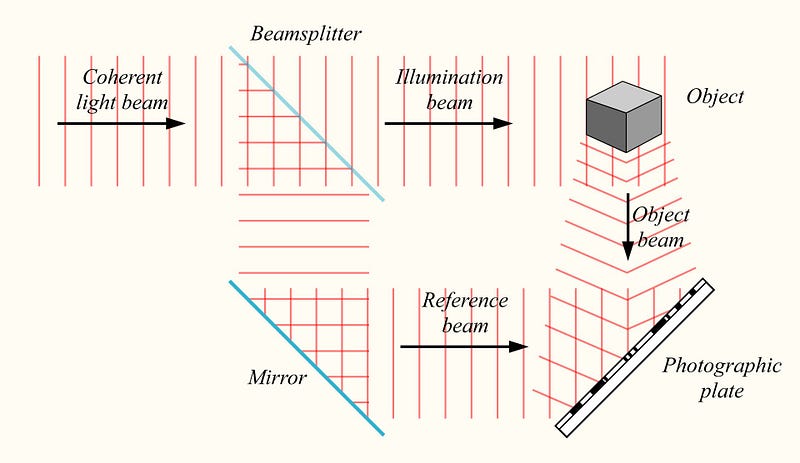
The essence of hologram technology is that, instead of capturing the intensity of light beams on a photographic plate, it records their phase. While this process loses color information, in return, if we illuminate it with the same laser used to make the recording, the light beams emerge in the exact phase as they would from the real object. That’s why we perceive the hologram as three-dimensional. In Jepsen’s patent, the display plays the same role as the photographic plate in a hologram, but while the photographic plate is static, this display is dynamic. Unlike traditional holograms, these holograms are incomprehensible to the human eye. However, they offer the possibility to focus light through human tissue. It’s akin to placing a lens in front of a blurry image to obtain a clear, focused picture, except here, the lens is made of human flesh and bones.
On the right side of the diagram, a “holographic camera” (160) is depicted, which differs from a traditional camera in that it captures a “hologram.” This means that, like the projector, it records the phase of light instead of its intensity. The operation of the system is very similar to how a traditional hologram is recorded on a photographic plate using a reference laser, but here, instead of a photographic plate, there’s an image pixel array (170). This setup enables the camera to capture the nuanced phase information of the light.
In the center, marked as “diffuse medium” (130), is the human tissue that we want to observe. This is the medium onto which the hologram is projected, and it’s calibrated until the tissues in the observed area focus the light. The light that exits the tissues is captured by the camera, from which the necessary information can be extracted.
The system also includes an ultrasound emitter (115), which helps in focusing the light. With focused ultrasound, the frequency of the light passing through a given area can be altered, thus “tagging” the light beams. With this technology, the information originating from the observed area can be selected. Therefore, with the help of focused ultrasound, we can find the holographic pattern that is most suitable for observing the given area. Once the necessary pattern is found, the system can operate without ultrasound. The following figure shows this process:
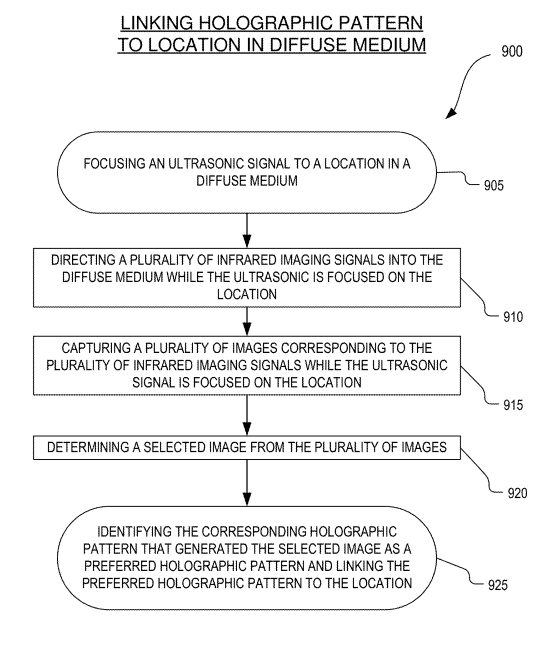
In a nutshell, this is how Jepsen’s microscope (built from flesh and bones) works. For those who are interested in a deeper understanding of the system, I recommend reading the patents. (I also had a more detailed article about the topic from 2019.)
With this ingenious device, we can create images of the human body with a resolution superior to that of an MRI, and there’s no need for massive magnets and expensive equipment. Jepsen’s tool is affordable, accessible to everyone, and can fit in a box the size of a mobile phone or even be integrated throughout the day into our clothing.
Even more exciting is the possibility that with focused light, we can not only peer into the human body but also induce changes within it. For instance, if cancer has already developed in our body, we can use light to destroy cancerous cells or deliver light-activated toxins that target only the cancer cells. (The OpenWater team is currently conducting experiments with focused ultrasound to ‘explode’ cancer cells. The procedure works well in tissue samples, making this technology very promising.)

What OpenWater offers in healthcare is fascinating, yet my enthusiasm for this technology lies elsewhere. Those who regularly read my articles know I am a big fan of Brain-Computer Interfaces (BCIs). I believe that following the Internet and Mobile communication (and maybe the VR revolution), the next major technological revolution will be the BCI revolution. And BCI will be the greatest innovation of human kind. OpenWater presents a very promising solution for this, as its device allows for neuron-level observation of the brain, all in a non-invasive manner (no surgery required, unlike Neuralink, for example). Experiments are currently underway to reconstruct dreams, visual images, or human speech based on fMRI data. These experiments are very promising, but they require the patient to lie inside a large tube (the fMRI machine). Jepsen’s technology would replace this with a simple cap. Imagine a net cap capable of recording our dreams while we sleep.
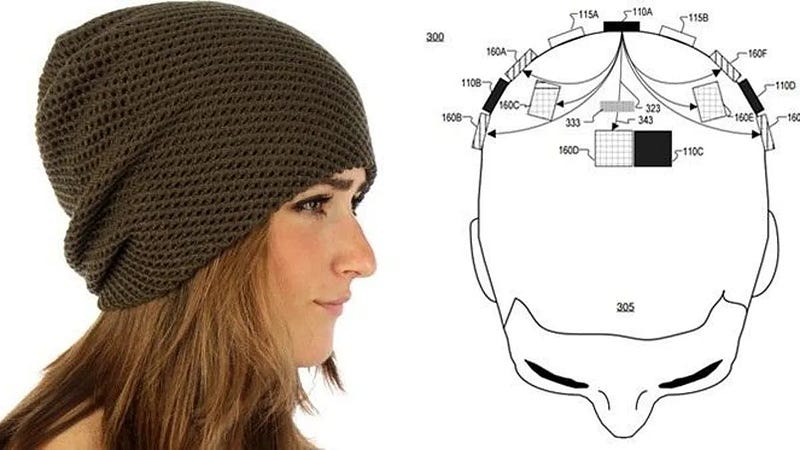
Another very exciting possibility is to focus on the spinal cord instead of the brain. Just think about it: all information from our brain to the entire body passes through a “bundle of wires” about 4 square centimeters in diameter (the spinal cord). The brain controls our limbs, our organs, and our entire body through this. If we can interpret this information, we might restore the ability to walk paralyzed people or build a virtual reality for them where they can live a full life. Since this is a smaller area than the entire brain, observing it might be much simpler than observing the entire brain, and the possibilities are fascinating.
Experiments are already underway with electrodes implanted in the spinal cord, but this technology is dangerous and has its own limitations. Instead of electrodes, we could inject nanoparticles, which convert electrical signals into light, thus making them detectable by the OpenWater device. Moreover, by activating the nanoparticles with light, we could stimulate specific points of the spinal cord. This ‘wireless’ solution is much less invasive than inserting electrodes into the spinal cord or the brain. It sounds like sci-fi, but it’s not.
In 2008, DARPA launched its Next-Generation Nonsurgical Neurotechnology (N3) program. One of the projects supported within this program is the Rice University MOANA project, which aims to achieve visual telepathy. The project received $18 million in funding from DARPA. The solution, similar to OpenWater’s approach, would use light to read the brain’s state and magnetic fields to activate neurons. However, this would involve using vector viruses and genetic engineering to modify brain cells so they can be activated by magnetic fields. This latter part might not sound so appealing, but perhaps it’s not necessary. With OpenWater’s technology, perhaps light alone could be sufficient for both writing to and reading from neurons.
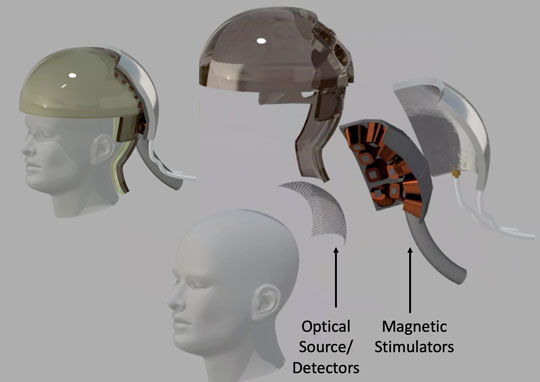
Whatever the winning technology turns out to be, it’s clear that many are taking Brain-Computer Interface (BCI) technology very seriously, investing millions of dollars in its development. This is hardly surprising, as such technology could potentially cure blindness, directly integrate prostheses with the brain, or even enable fully immersive virtual reality experiences. Perhaps the very technologies that current researchers are developing for better VR headsets (such as higher resolution miniature displays, dedicated processors, etc.) could in the future be used to project images directly into our brains using lasers. This merging of advanced imaging and neurotechnology could revolutionize not just healthcare, but the way we interact with technology itself.
One might think that if someone possesses such a significant technology, they would guard its details as closely guarded secrets, providing access only for substantial sums of money. However, OpenWater chose a different path: in January 2024, they announced that they would make the technology open-source, including hardware blueprints, source codes, patents, measurement data, etc. It’s difficult to determine what is more revolutionary: the technology itself or the philosophy and business model behind it. This approach not only accelerates innovation by allowing others to build upon and improve the technology but also democratizes access, potentially leading to widespread applications in various fields beyond just healthcare and computing.
Obviously, open source is not synonymous with non-profit activity. OpenWater has a sustainable business model. Instead of making money on patents, it focuses on products and services. This is very similar to what Google did with Android, which is also open-source, and with which it dominated the mobile phone market. Therefore, OpenWater has a good chance of generating significant profits alongside open knowledge. I believe that in the future, most companies will switch to this model, as otherwise, they will not be competitive. Furthermore, the exponential nature of humanity’s scientific and technological advancement can only be sustainable if companies adopt such an open-source model. So, OpenWater is “Free as in Speech, Not Free as in Beer”.
If you’re a researcher, developer, BCI expert, or simply someone interested in technology, you can access everything on GitHub and the company’s website. I would encourage everyone whose field is even slightly related to OpenWater to review the materials and contribute to the technology’s development. This is genuinely a breakthrough that could bring about a change in the whole of humanity.
UPDATE: I want to build a minimal implementation of Jepsen‘s wearable MRI-like holographic device (if it is possible on a small scale). So, if you are a maker or something like that, or simply interested, join the conversation here: https://www.reddit.com/r/openwater/comments/196pur8/openwater_developer_board_for_hobby_developers/
Some other articles from me on the topic:
I admit that the title may seem strange at first. Why are Brain-Computer Interfaces among humanity’s most important…medium.com
These days, virtual- and augmented reality is a very hot topic. For example, one of the most valuable startups is…thebojda.medium.com
My sci-fi stories on the topic:
I’m basically a tech writer, but sometimes I write short sci-fi novels. Usually, I write them in my native language. In…medium.com
I despise Christmas. The city becomes like a pestering showroom, seemingly designed to provoke me. Flaunting what they…thebojda.medium.com
And a last one about why join the OpenWater community: